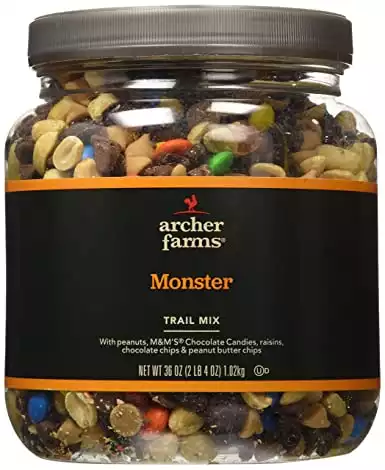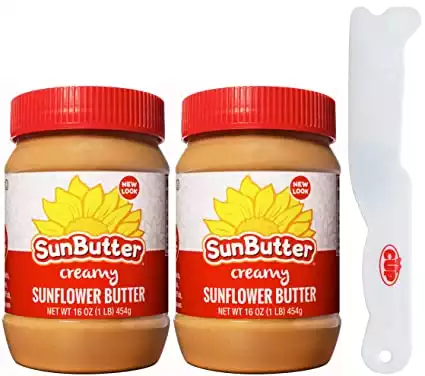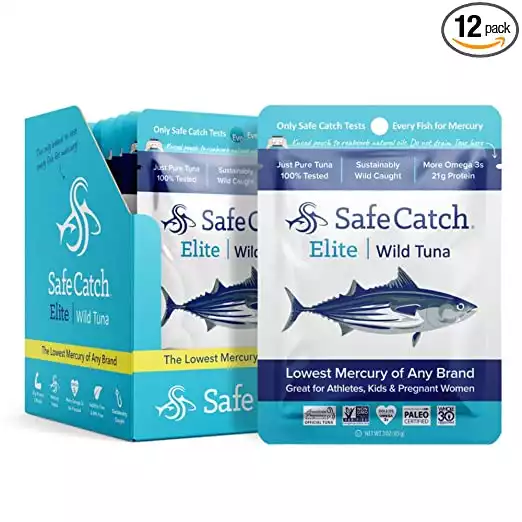Camping is fun, but cooking food and trying to keep it refrigerated isn’t.
In fact, at the end of a long hiking day, the very last thing you want to worry about is cooking up dinner before you head to bed. What’s more, there’s nothing more challenging than trying to how to keep food cold in the mid-summer heat when you’re camping without electricity.
Thankfully, we’ve got you covered. In this article, we’re going to introduce you to 9 options for camping food, no cooking, no refrigeration required. These 9 camping food list are the perfect addition to any outdoor menu, so they’re a must-pack when you’re making your camping checklist for your adventure.
Let’s get started!
The 9 Best Camping Foods: No Cooking, No Refrigeration
1. Trail Mix

A time-honored classic, there’s really nothing better than snacking on trail mix when you’re in the mountains.
From a nutritional perspective, trail mix is a fairly decent choice, too. That’s because, despite trail mix’s high sugar content, it’s packed full of protein and fat.
All those nuts and seeds provide your body with much-needed macronutrients, like protein, which is essential for repairing your tired muscles. Furthermore, the fat in nuts also helps provide your body with a long-term energy source as you charge up the trail.
If that wasn’t enough, if you mix some dried fruit, like raisins or cranberries in your trail mix, your body also gets some important vitamins and minerals. Oh, and while sugar isn’t necessarily great for us, the little sugar boost in the chocolate and dried fruit in trail mix is great fast energy as you hike.
The best part about trail mix? It’s highly customizable. While we really like buying bulk trail mix, like the Archer Farms Monster, when we’re short on time, you can also make your own mix at home.
- Comes with M&M, peanuts and raisins
- Available in three different packs
- Can be a topping for any kind of breakfast
Some of our favorite things to put in trail mix include:
- Almonds
- Cashews
- M&Ms
- Dried blueberries
- Sunflower seeds
- Peanut butter chips
- Raisins
- Mini pretzels
However, you can easily adjust your trail mix to suit your personal tastes and dietary needs. For added fun, you could make one trail mix that’s sweet and another that’s savory, so you always have something to enjoy in the mountains.
2. Granola Bars
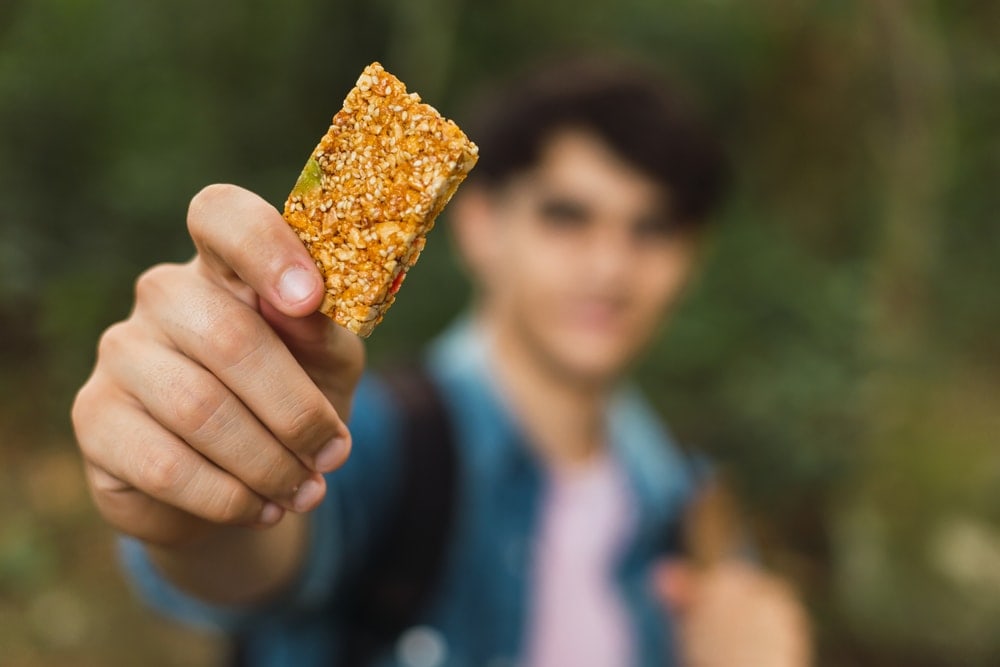
Another popular choice, granola bars (a.k.a. protein bars) are ideal when convenience is key. Like trail mix, granola bars can provide a lot in terms of nutrition, depending on what bar you choose.
For example, many granola bars come chock full of nuts, which offer the same protein and fat benefits that you’d get when eating trail mix. Meanwhile, many other granola bars also feature bits of dried fruit for a splash of vitamins and a dash of sugar to help keep your energy up.
That being said, not all granola bars are created equal. Indeed, while many people think that granola bars are a nutritious choice, some are certainly better than others.
In particular, some brands are really high in processed sugars and low in other essential macronutrients like protein. As a result, they don’t provide the nutrition that you need while hiking.
Nevertheless, there are a whole lot of different granola bars to choose from, so we recommend picking a selection for your trip. Doing so will help keep your snacks exciting so you always have something to look forward to when you stop for a meal break.
Some of the most popular granola bars out there include Clif Bars, which are available in pretty much any flavor you can choose from (the cool mint is a personal favorite).
Alternatively, you can make your own no-bake granola bars at home. To do so, you can combine pitted whole dates, cashews, and any other dried fruit in a food processor. Add cinnamon and other spices as desired to taste and then form the mixture into bar shape. Wrap the bars up in plastic wrap and then you have homemade granola bars to take with you on the trail!
3. Jerky & Summer Sausage
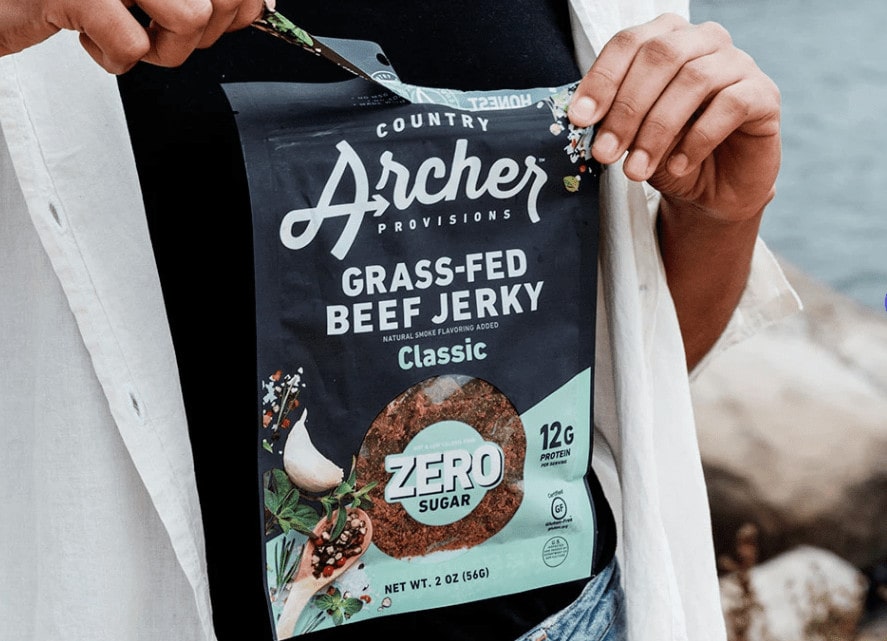
For the carnivores out there, jerky and summer sausage are solid trail food options. Since neither jerky nor summer sausage needs to be refrigerated or cooked, they’re a great choice for your hiking adventures.
As far as jerky goes, you can get nearly any type of flavor and meat combination you can think of. In fact, Country Archer Chile Beef jerky is one of the most popular options out there, especially if you’re looking to purchase from an environmentally-conscious brand.
That being said, jerky can get quite pricey, especially if you’re looking to pack for a longer trip. So, many folks opt to make their own jerky at home (usually from beef). To make your own beef jerky, you’ll need meats, seasonings, a dehydrator, and a whole lot of time. But, if you plan your prep wisely, you can end up with a whole lot of jerky for your adventures.
When it comes to summer sausage, you also have quite a few options. Most grocery stores sell summer sausage or prosciutto, so you can often find a flavor that’s to your liking.
Since summer sausage comes pre-cooked, you don’t have to worry about whipping out your stove whenever you want to indulge. Instead, we recommend adding your summer sausage to your sandwiches and wraps or pairing it with cheese and crackers for a quick snack on the trail.
4. Peanut Butter
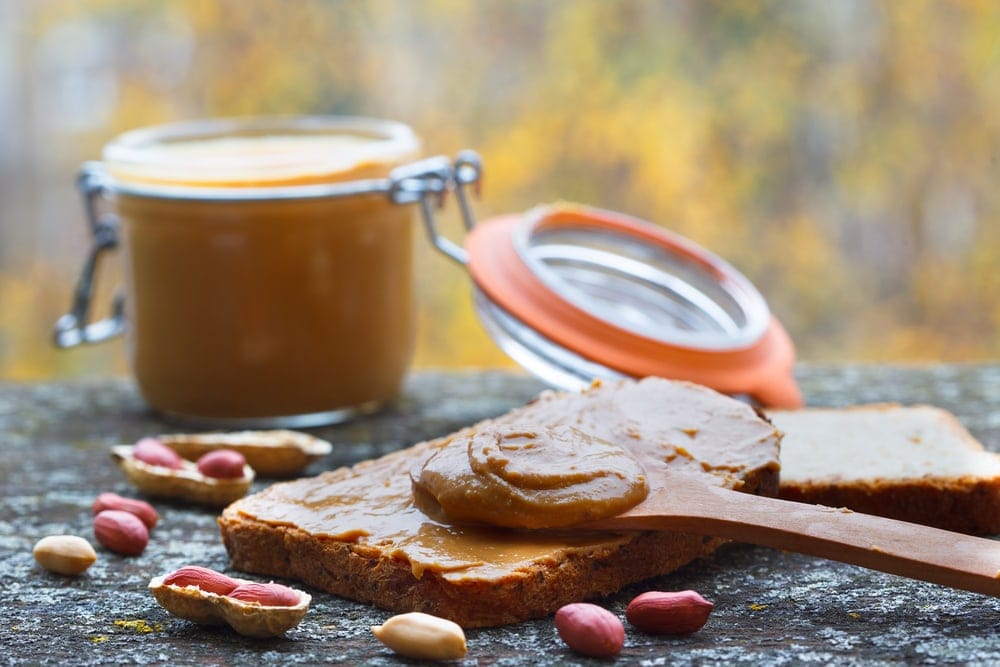
There are few campers who head out into the woods without peanut butter in tow, and for good reason: it’s nutritious and delicious.
Interestingly, despite their name, peanuts are not a nut, but a legume. In reality, this makes little difference on the trail, as peanuts are naturally very high in protein and fat, just like their nut cousins.
That being said, not all peanut butters are created equal. Like every tasty delight, some peanut butters are better for you than others. However, the nutritional content of your peanut butter really comes down to the ingredients.
While some companies make their PB with nothing other than peanuts and salt, others add lots of sugar, palm oil, and other ingredients for more flavor. Which one you choose is up to you, though it’s worth pointing out that you can always make your own peanut butter at home with peanuts and a food processor.
If you’re wondering why we like peanut butter so much as a trail food, the answer’s quite simple: peanut butter is incredibly versatile. You can add it to wraps and sandwiches or eat it plain. Or, if you are bringing a stove for dinner purposes, you can always use peanut butter to make a pad thai-like sauce for your quick-cooking rice noodles. Yum!
Oh, and if you’re allergic to peanuts, have no fear.
Depending on your allergies and dietary restrictions, you could opt for almond butter or sun butter, the latter of which is nut-free and made from sunflower seeds. SunButter also comes in little packets, which is ideal if you’re planning a short trip into the mountains.
- Made with roasted sunflower seeds in a peanut
- Certified gluten-free and OU Kosher
- Free from food allergens: peanuts, tree nuts, milk, eggs, wheat, fish shellfish and soy
5. Cheese
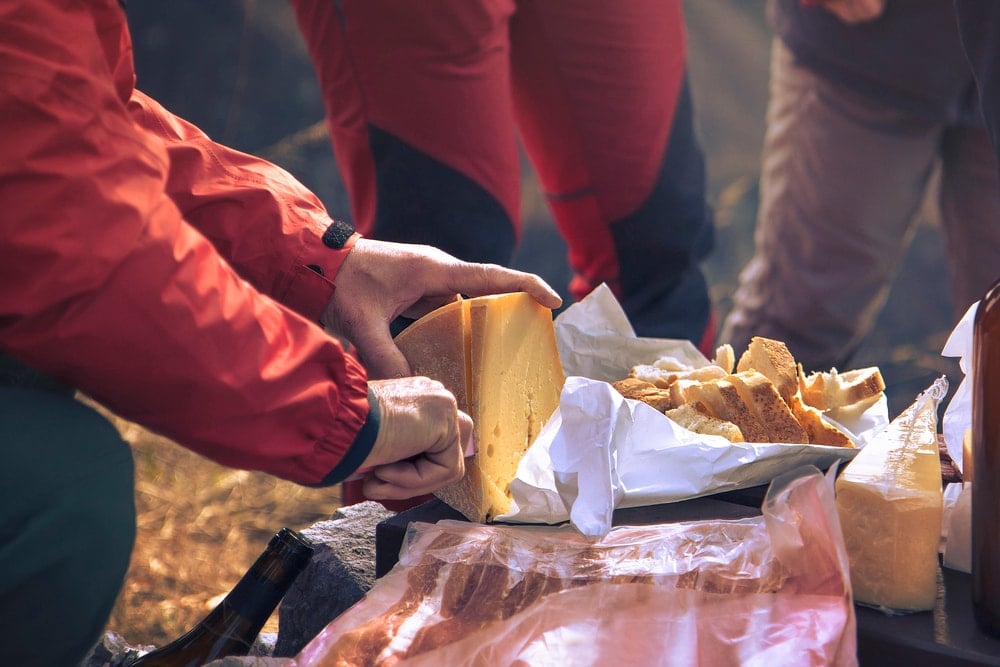
Okay, we get that most people who live in North America are used to refrigerating their cheeses, but it turns out that most cheeses don’t need to be kept cold.
What?!
Yep, that’s right. Firm and hard cheeses, like cheddar, parmesan, Colby jack, and gouda, are pretty low on moisture and whey content. This means that they can actually maintain their freshness and flavor fairly well, even when they’re not refrigerated. As a result, they’re a great addition to any camping trip.
Nevertheless, we do not recommend packing any soft cheeses, like mozzarella, blue cheese, feta, brie, or camembert, no matter how fancy you want to make your meals. That’s because these cheeses have a really high moisture and whey content, which means they’ll spoil quickly in the heat.
Hard and firm cheeses, however, are fair game for any outdoor adventure, and they’re one of our favorite cooking and refrigeration-free foods. If you want to make your cheese last longer, it’s worth wrapping it in parchment paper, which allows the cheese to breathe properly.
Then, when you’re outside, you can add the cheese to your sandwiches or eat it plain with crackers for a nice treat on the trail.
Oh, and if your cheese starts to sweat on the trail? It’s nothing to worry about. Sweaty cheese is actually just what happens when the butterfat in cheese separates from the solids. All this means is that your cheese will start to lose flavor since the “sweat” on your cheese is just fat—not anything that’s likely to make you sick while you hike.
6. Granola
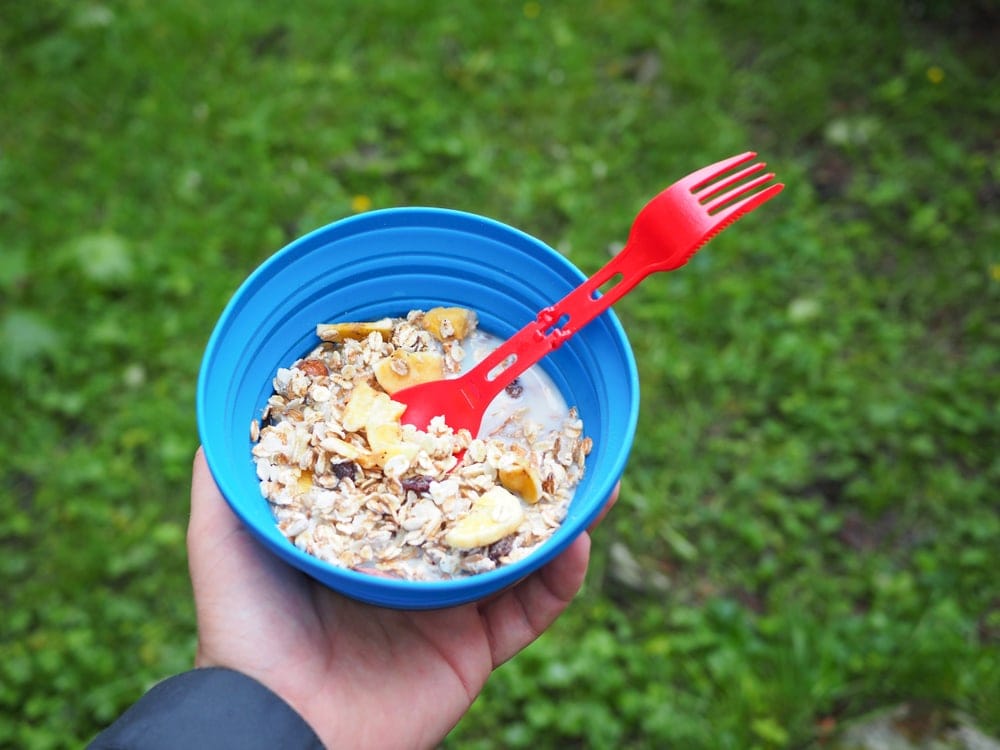
The perfect breakfast or snack, granola is a fan-favorite while camping. Although many of us get our fill of granola through granola bars, packing little baggies of granola into the mountains is also a solid choice.
In addition to being an easy snack food, granola can make your alpine breakfasts as quick and simple as can be. While you could just eat your granola plain, adding a bit of powdered milk, like the Hoosier Hill Farm All-American Whole Milk Powder, adds a nice splash of protein and flavor.
To do so, you simply need to combine a bit of the milk powder and some purified water or boiled hot water to make a little cereal bowl for breakfast. It’s also worth adding in some dried or fresh fruit, nuts, and seeds for added protein and nutrition for your day of hiking.
One of the best things about granola is that you have so many different options to choose from. In most grocery stores, you have a choice between dozens of different brands, so you can get the granola you want based on your dietary preferences.
For campers on a budget, you can also make your own granola at home by mixing rolled oats, nuts, seeds, salt, cinnamon, coconut or olive oil, maple syrup or honey, and chopped fruit. Then, you simply need to cook your mixture in the oven for about 20 to 25 minutes, let it cool, and then pack it up in little baggies for a quick breakfast solution on your outing.
7. Bagels
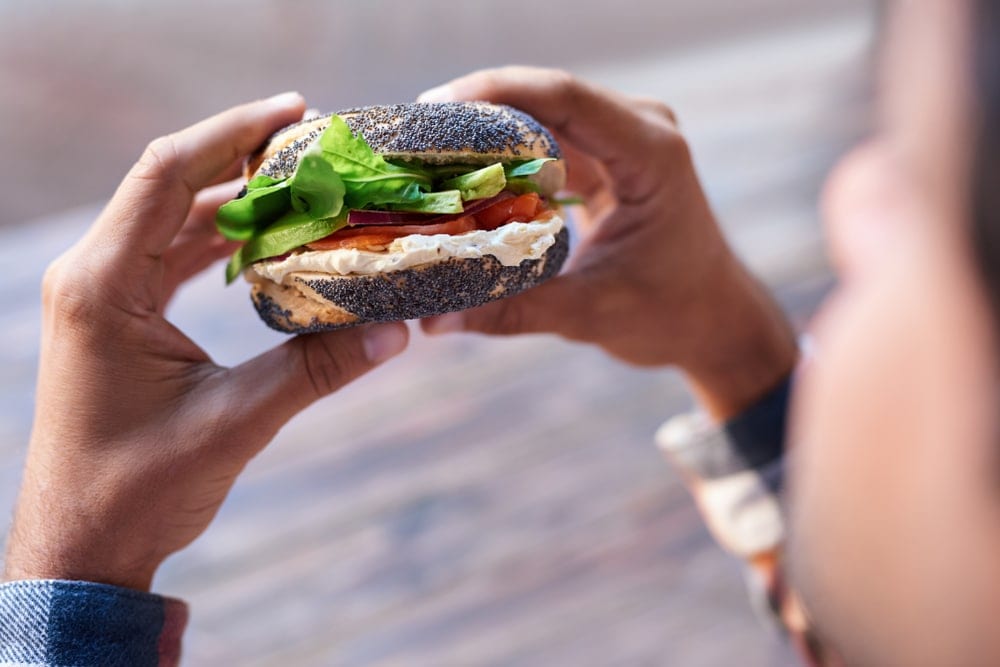
For short backpacking or camping, bagels are one of the ultimate camping foods. Not only are bagels absolutely delicious, but they can be the perfect snack or camping meal, regardless of the conditions.
In general, bagels (the type you’d buy at the grocery store, not freshly boiled bagels from a proper bagel shop) tend to hold up better than bread in the mountains. That’s because bagels tend to be a little less prone to getting smushed than their loaf-shaped cousins.
However, since bagels are quite bulky, we do recommend eating them fairly early on during your camping adventures. While this bulk is more of an issue for folks camping with a bear canister, it’s good to keep in mind regardless of your camping situation.
Plus, bagels pair really well with a lot of the other foods on our list. You can easily top your bagel with peanut butter for a protein boost in the middle of the day. Or, you can make a bagel sandwich with cheese and summer sausage for a quick lunch on the trail.
That being said, we want to comment briefly on gluten-free bagels on the trail. Unfortunately, gluten-free bagels tend to fall apart quite easily, so they’re not as robust as their wheat-filled cousins.
If you do really want to bring gluten-free bagels while camping, we’d highly recommend frying them on a wood stove or whatever stove you are using, with butter if you want to have an enjoyable meal. While that isn’t very no-cook friendly, it is the best option if you’re committed to having gluten-free bagels as part of your meal plan.
8. Tuna
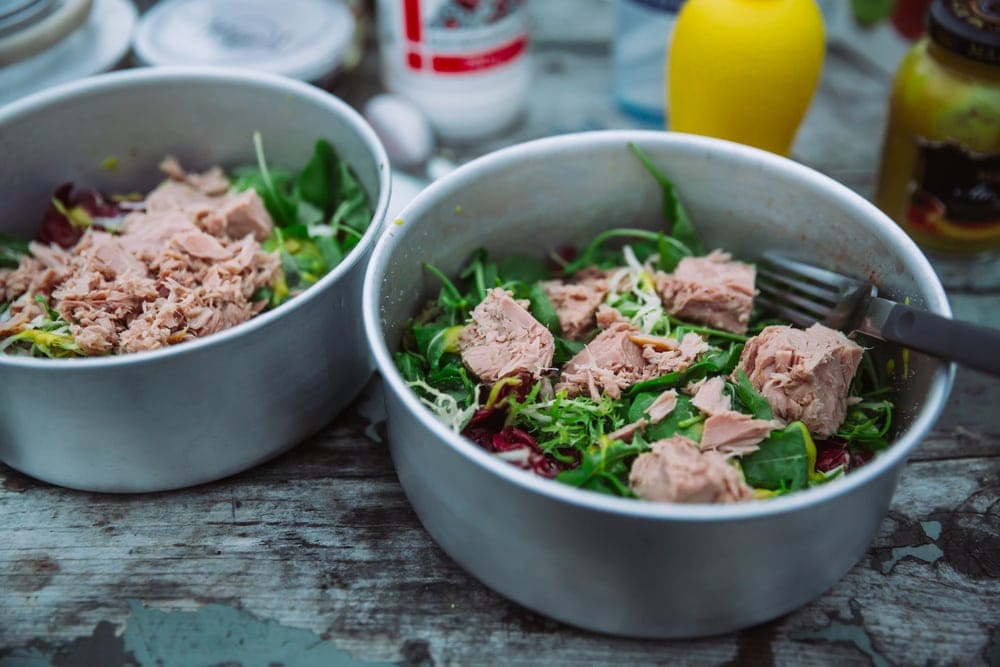
Tuna is one of the most under-rated no-cook, camping food ideas out there that don’t require a refrigerator. If you love seafood, then tuna is a great way to get omega-3 fatty acids and its high protein content is ideal for outdoor enthusiasts.
Plus, while you can buy fresh tuna, most of us opt for pre-cooked canned tuna when we’re eating it at home. However, although you certainly could bring cans of tuna into the backcountry, we’d recommend opting for tuna packets, instead.
Tuna packets, like the sustainably-caught Safe Catch Elite Pouches, offer a quick and easy way to get your tuna fix on the trail. You can eat tuna straight from the packet or add it to your bagels and sandwiches for a tasty meal.
- Non-GMO, paleo certified, & gluten-free
- Healthy food for athletes, kids, pregnant women
- With the lowest mercury count
If tuna isn’t quite your thing, you can often find salmon packets, instead. Both tuna and salmon packets are relatively lightweight, and they make for a great addition to your meals.
Furthermore, if you’re interested in keeping your seafood choices environmentally healthy while camping, we’d recommend checking out the Monterey Bay Aquarium Seafood Watch program, where you can get up-to-date recommendations on what species are sustainable to eat at any given time.
9. Chocolate
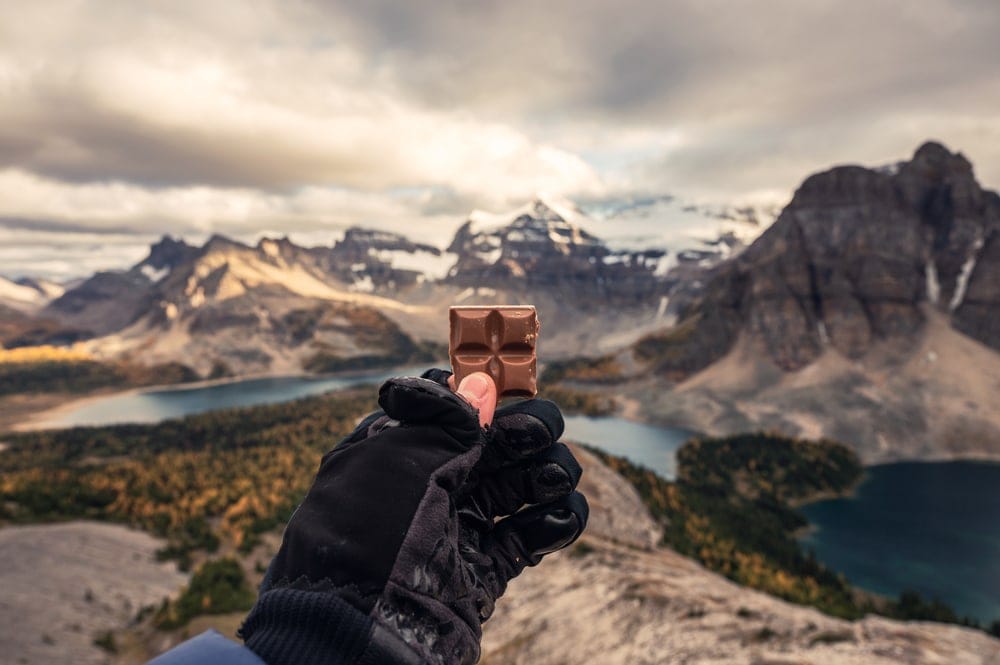
Now, we know that you probably didn’t expect something as melty and temperamental as chocolate to make it onto our list of the best no cooking, no refrigeration camping foods, but hear us out.
Chocolate is objectively tasty, so we think it deserves a spot on any camping menu. Plus, while chocolate does indeed melt, this melting doesn’t impact the flavor of your snack (unless you’re eating really fancy chocolate).
As a result, we never head into the mountains without chocolate in tow. A couple of bars of chocolate, like the eco-friendly Endangered Species Fair Trade Dark Chocolate, are always ideal while backpacking as they allow for a sweet treat at night.
If eating bars of chocolate isn’t your thing, then you might find that M&Ms are a better choice. In moderate summer temperatures, the candy shell on M&Ms does tend to prevent melting, though you should expect the colors of your sweets to melt all over your hands.
Oh, and if the chocolate melts? Well, it will eventually re-harden at night, so worry not. But, you can always eat the chocolate while it’s melted and consider it a free, natural chocolate fondue, courtesy of Mother Nature herself. What could be better?
FAQs
How To Store Food While Camping?
Figuring out how to store food properly while camping starts with understanding the limitations of your camping location. If you’re in a campground with hookups, you could store your food in a cooler or portable fridge.
Alternatively, for backpacking trips, you’ll likely need to store your food in a bear-proof canister or in a bear hang. However, your food storage options will depend on local regulations and requirements in your camping location.
How to Prepare Food For Camping?
When camping, you can either prepare food on a stove or a fire. Stoves are actually the most environmentally-friendly and efficient option, though some enjoy the rustic nature of cooking on a fire. Or, you can always skip the stove and the fire and choose camping foods that don’t require refrigeration or cooking.




